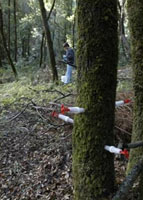*This page is currently under review to provide the best information available. In the meantime, please refer to the links below and reach out to a Contact for more details.
Management: Swiecki, Tedmund J.; Bernhardt, Elizabeth A. 2013. A reference manual for managing sudden oak death in California. Gen. Tech. Rep. PSW-GTR-242. Albany, CA: U.S. Department of Agriculture, Forest Service, Pacific Southwest Research Station. 129 p.
Treatments

While there is no cure for Sudden Oak Death or other P. ramorum-associated diseases, there are preventive measures that may protect plants. The publication “Protecting Trees from Sudden Oak Death Before Infection” provides helpful treatment information for areas not currently infested but at risk.
Guidance for application and use of phosphonate chemical treatments (such as Agri-fos® ) is available at the UC Berkeley Forest Pathology and Mycology laboratory. More information about removing bay trees that are growing near susceptible oaks is available at the Phytosphere Research website.
Restoration
What should be planted to replace a tree that was killed by P. ramorum?
If you want to replant, it is important to choose a plant that will suit your needs and adapt well to the site. There are many resources available that can guide you to making the right choice. Check to see if there are any local ordinances or guidelines that govern tree replacement or planting.
Resistance to P. ramorum in oak trees is just beginning to be explored. Resistant planting stock is not available at this time, nor is it known if it will ever be available. If you want to replant the same species of tree that was lost, there is a risk that the new tree may also suffer from the disease. If you have space for replanting many trees, consider replanting the same species in combination with other trees that don’t get the disease. Thus, if some trees are lost to P. ramorum there will still be other trees that survive.

Restoration of Oak Woodlands: This report describes in detail the planning and implementation of restoration measures for oak woodlands that have been impacted by P. ramorum. It includes guidelines for determining the current status of the land, deciding what you hope to achieve with the restoration, and determining how you plan to execute the restoration.


